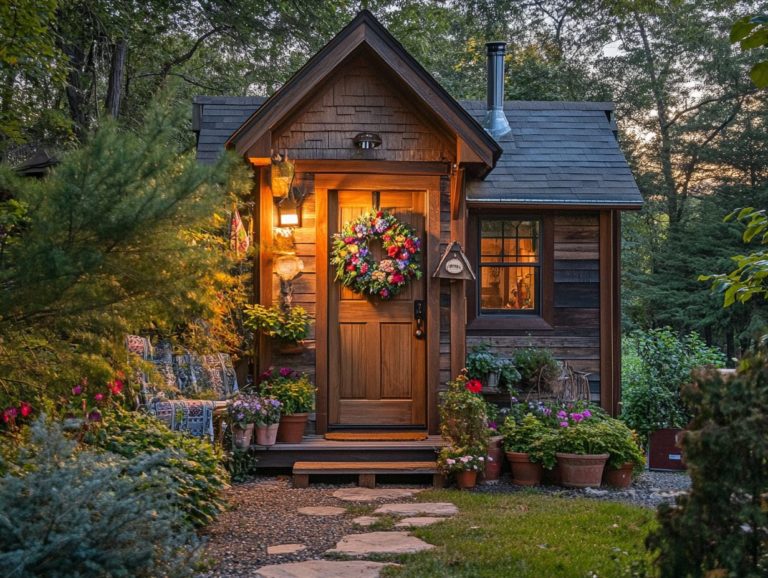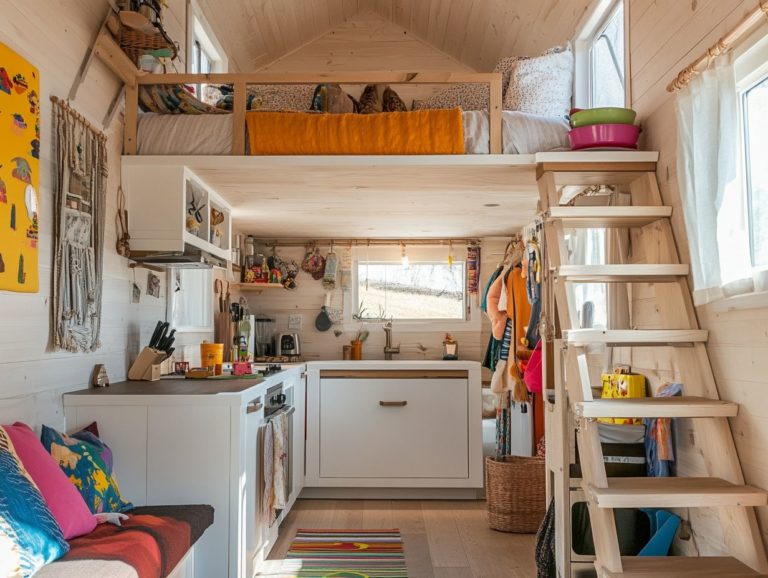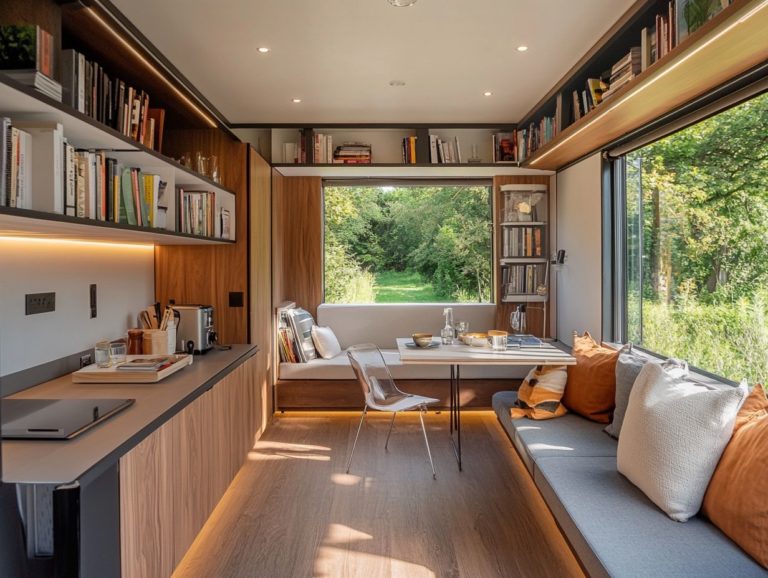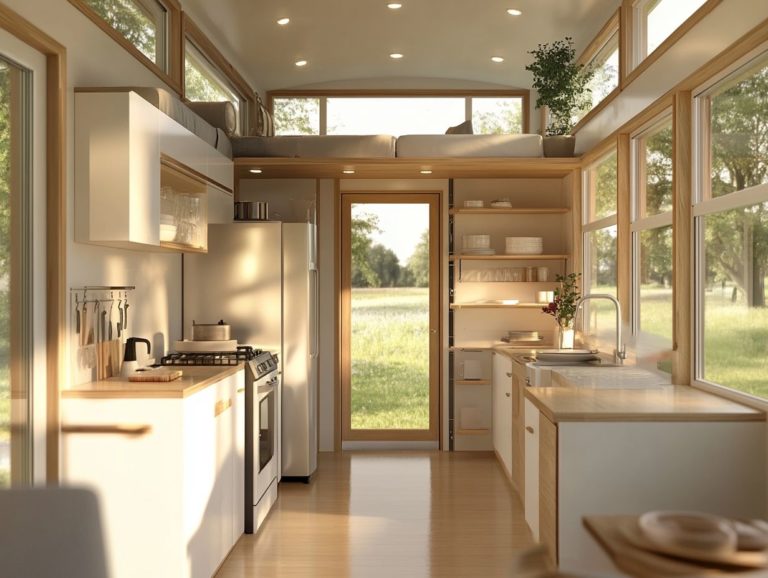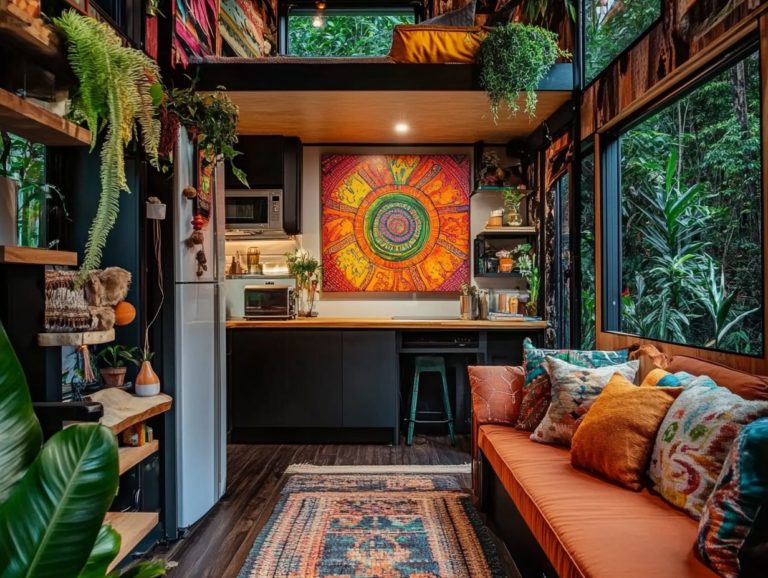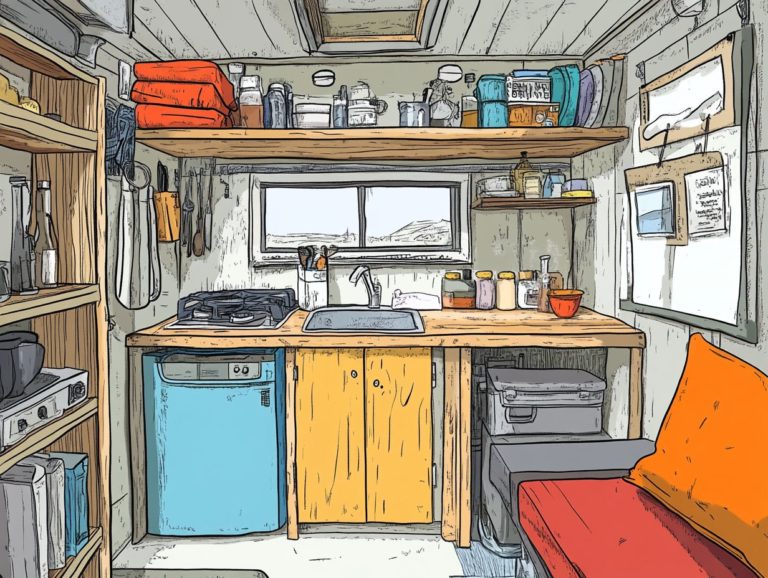Creating a Tiny House Garden: Design Tips
Living in a tiny house invites you into a unique lifestyle brimming with creativity and sustainability, especially when it comes to gardening in your outdoor space.
A tiny house garden enhances your limited space. It also offers fresh produce, improves air quality, and creates a tranquil atmosphere for outdoor living.
You ll discover the myriad benefits of a tiny house garden, along with landscaping tips that help you maximize your space. You ll also find recommendations for the best plants suited for container gardening and sustainable practices that will ensure your garden thrives.
Whether you’re a seasoned gardener or just starting out, there s something here for everyone to create a flourishing green oasis in your tiny home.
Contents
- Key Takeaways:
- Benefits of a Tiny House Garden
- Designing Your Tiny House Garden
- Choosing the Right Plants for Your Tiny House Garden
- Caring for Your Tiny House Garden
- Incorporating Sustainable Practices
- Frequently Asked Questions in Tiny House Gardening
- What is a tiny house garden, and how does it fit into urban gardening?
- What are some design tips for creating a tiny house garden that maximizes outdoor space?
- What are the benefits of having a tiny house garden for outdoor living?
- How do I choose the right plant varieties for my tiny house garden?
- Can I incorporate a water feature like a birdbath in my tiny house garden?
- Are there any specific design considerations for a tiny house garden, particularly for mobile tiny houses?
Key Takeaways:
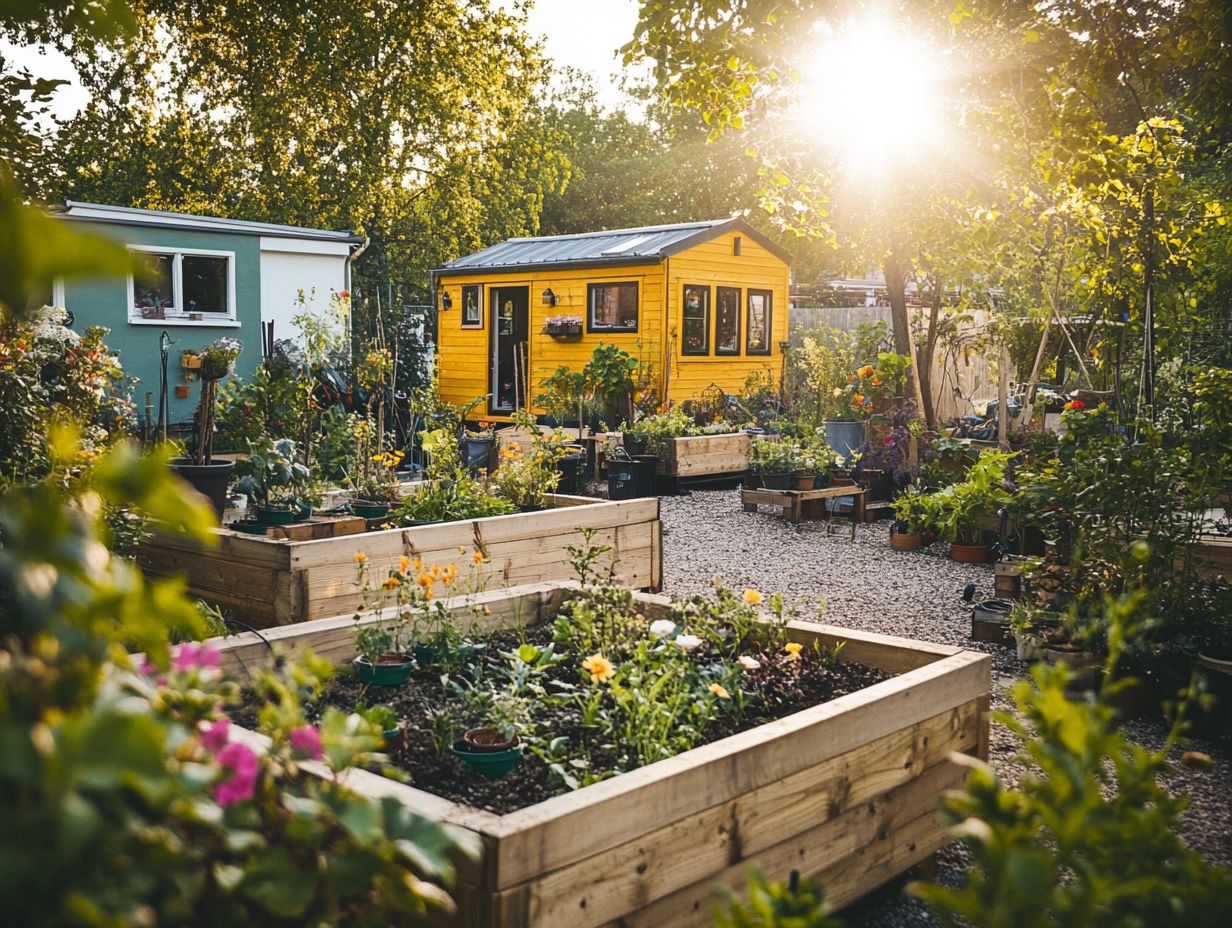
- Create a tiny house garden for a healthier and more sustainable lifestyle.
- Maximize limited space by considering factors such as sunlight, soil quality, and plant size.
- Choose easy-to-care-for plants and incorporate sustainable practices like using recycled materials and composting to maintain your tiny house garden.
Benefits of a Tiny House Garden
The benefits of a tiny house garden go well beyond aesthetics; they embrace sustainable living practices perfectly suited for micro homes and those aspiring for financial freedom.
A well-designed garden can elevate your outdoor space and promote eco-friendly habits that reduce maintenance and enhance enjoyment.
As the tiny house movement gains momentum, more people are discovering the joy of having a garden, which can play a pivotal role in fostering a fulfilling and sustainable lifestyle, even within small spaces.
Advantages for Tiny House Living
One of the key advantages of tiny house living is your opportunity to cultivate a garden that directly contributes to an eco-friendly lifestyle while enhancing your outdoor experience. This lifestyle choice aligns seamlessly with your quest for financial freedom, significantly reducing long-term expenses related to maintenance and utilities, allowing you to invest in features like an outdoor kitchen.
A thoughtfully planned garden can provide you with fresh herbs such as citronella grass and lavender, and vegetables, allowing you to cut down on grocery bills and embrace healthier eating habits.
The minimal maintenance required for such gardens especially when utilizing sustainable techniques like permaculture (a system of agricultural design principles that simulates natural ecosystems) or companion planting makes gardening accessible, even if you have limited experience.
Start this garden-centric approach now to enjoy cleaner air, boost biodiversity in your surroundings, and savor the satisfaction of nurturing your own food supply. These practices cultivate a sense of community and elevate the overall enjoyment of tiny home living, making it perfect for retirees and millennials alike.
Designing Your Tiny House Garden
Designing your tiny house garden calls for a careful blend of landscaping tips and ideas that elevate your garden s design while making the most of limited space.
A well-crafted garden design integrates a variety of landscape elements and decorative features, ensuring that the outdoor aesthetics harmonize with your vision of sustainable living and reflect your personal tastes.
Factors to Consider
When designing your tiny house garden, keep several critical factors in mind. Think about the overall garden design, the types of plant varieties such as climbing plants that flourish in limited outdoor spaces, and the addition of decorative elements like privacy screens.
In this compact setting, it s essential to understand the sunlight patterns throughout the day, as they play a vital role in your plants’ health and growth. Assessing water availability whether through a rainwater collection system or a nearby source will greatly impact the garden’s sustainability.
Selecting the right plant varieties, such as drought-resistant species or herbs like basil and rosemary that double as culinary delights, enhances functionality and adds beauty to your space.
With a thoughtful approach, you can transform your tiny outdoor area into a serene oasis complete with a fire pit, brimming with life and character, while making the most of every square inch for both aesthetic pleasure and practical use.
Maximizing Limited Space
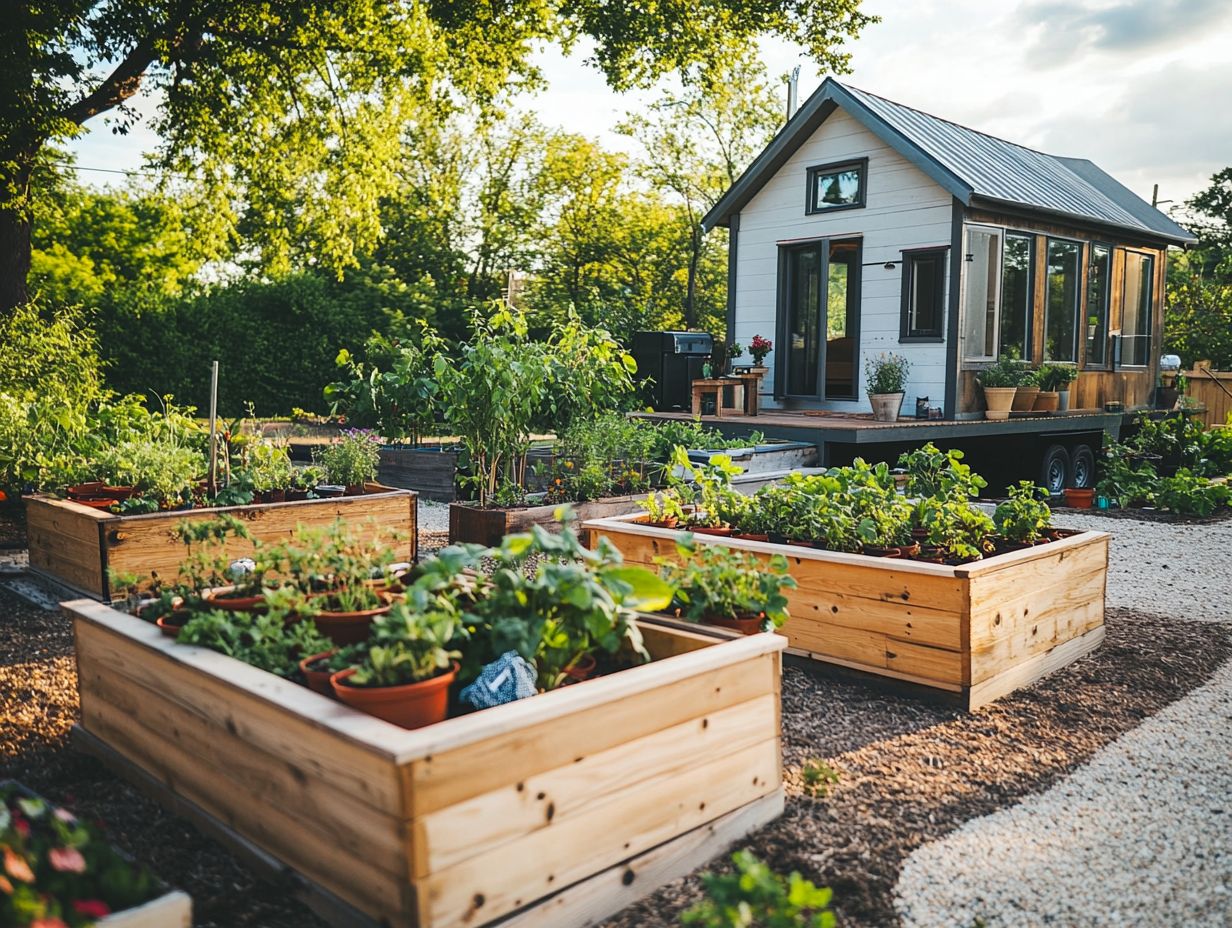
Maximizing limited space in your tiny house garden calls for innovative solutions like vertical gardens (growing plants up on walls or shelves) and container gardening. These methods help you make the most of your small outdoor area while enhancing your living space.
Using wall-mounted planters and hanging pots transforms previously unused wall areas into vibrant, green backdrops, enhancing your outdoor aesthetics. Compact containers made from lightweight materials simplify rearranging your layout and open up a world of plant possibilities, from fragrant herbs to cheerful flowers like marigolds and zinnias.
Use multi-functional furniture. Benches can store gardening tools while providing seating. This maximizes usability and keeps your garden organized and visually appealing, making it a great addition to tiny home living. For more insights on optimizing space, check out designing for dual purpose. With these strategies, every square inch of your garden can serve a purpose.
Choosing the Right Plants for Your Tiny House Garden
Selecting the ideal plants for your tiny house garden is essential for cultivating a flourishing ecosystem that complements your lifestyle. It elevates outdoor aesthetics and supports a minimalist lifestyle. Incorporate a diverse range of plant species, from native plants that thrive in your area to aromatic herbs and climbing varieties that enhance vertical gardening options.
This approach enhances the beauty of your space and offers practical benefits that enrich your gardening experience.
Types of Plants to Consider
- Herbs (e.g., basil, rosemary, and thyme)
- Climbing plants (e.g., peas and pole beans)
- Succulents for low maintenance
Culinary herbs thrive in compact areas, infusing your meals with fresh, delightful flavors. Climbing plants allow you to create stunning vertical gardens, maximizing growth potential while conserving ground space. Succulents, with their diverse shapes and vibrant colors, require minimal upkeep, making them ideal for busy lifestyles and enhancing the landscape appeal of small spaces.
Incorporating these plants transforms your tiny garden into a productive oasis, contributing to a sustainable lifestyle and enhancing your outdoor retreat.
Container Gardening Tips
Container gardening is an ideal strategy for tiny house owners, enabling you to make the most of limited space while enhancing the visual appeal of your landscape.
Select the right containers; consider lightweight resin pots, garden towers, or vertical wall planters. You can creatively transform every nook into a vibrant green oasis. Additionally, think about the importance of outdoor spaces in tiny house design. Pay attention to soil types; using well-draining potting mixes is crucial. This helps your plants thrive with the right amount of moisture without risking waterlogging (too much water in the soil that can harm your plants) or runoff.
Placement is key. Maximize sunlight exposure and airflow by arranging taller plants in the back and smaller ones in front. This layered look enhances landscape design and cultivates a flourishing garden. It also creates a stunning visual display that can include features like an outdoor kitchen or a fire pit. This strategic approach boosts aesthetic value and supports a diverse array of plants, perfect for small space gardening and urban gardening.
Caring for Your Tiny House Garden
Caring for your tiny house garden requires an array of eco-friendly practices that emphasize effective watering, meticulous maintenance, and mindful pest control. By adopting these methods, you ensure the longevity and health of your plants while embracing the principles of sustainable gardening.
Watering and Maintenance
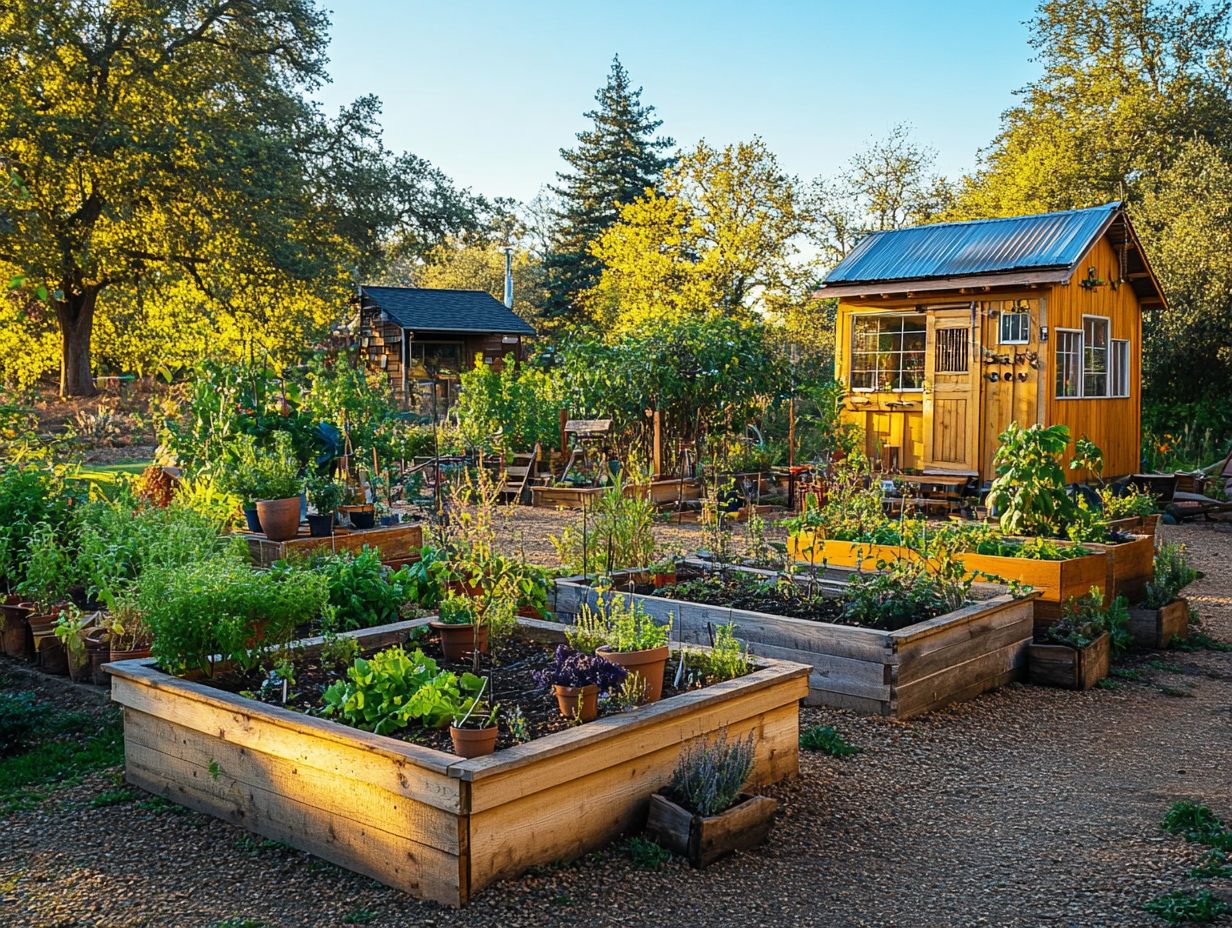
Effective watering and maintenance are essential elements for growing a successful tiny house garden. Focus on eco-friendly methods that minimize water consumption and demand low upkeep for lasting sustainability, such as using drip irrigation.
By embracing efficient watering techniques, such as drip irrigation, a method that delivers water directly to the roots of plants, or soaker hoses, you can drastically cut down on water waste while supporting the principles of sustainable gardening.
Incorporating rain barrels to collect and store rainwater offers an excellent way to nourish your plants while being kind to the environment. Choosing native or drought-resistant plants helps them thrive in your local climate and reduces the need for constant watering.
Mulching your garden beds retains moisture and makes maintenance a breeze, creating a serene and manageable space for you as a tiny house dweller, perfect for outdoor retreats.
Dealing with Pests and Diseases
Dealing with pests and diseases in your tiny house garden calls for an eco-friendly approach that embraces native plants and sustainable practices. This allows you to minimize harm while effectively managing infestations in your garden beds.
By cultivating a diverse array of species, including climbing plants, you can create a resilient ecosystem that naturally deters unwanted bugs and diseases, enhancing your outdoor aesthetics.
Take companion planting, for example; it attracts beneficial insects and helps thwart common garden nuisances while also contributing to the overall landscape appeal of your tiny house garden.
Incorporating organic materials like compost enhances soil health, promoting stronger plants that are less vulnerable to infestations. Regularly monitoring your plants for early signs of distress gives you the power to act swiftly, using organic insecticides, which are made from natural materials and help control pests without harming the environment, or physical barriers when necessary.
Ultimately, these proactive strategies cultivate a vibrant, thriving garden that flourishes while you remain committed to environmental stewardship.
Incorporating Sustainable Practices
Incorporating sustainable practices into your tiny house garden is crucial for fostering eco-friendly living and minimizing your environmental footprint. By utilizing recycled materials, composting organic waste, and implementing effective water conservation techniques, you can significantly elevate the sustainability of your gardening endeavors.
These strategies not only enhance the health of your garden but also contribute to a more harmonious relationship with the environment.
Using Recycled Materials
Utilizing recycled materials in your tiny house garden elevates both the aesthetics and the eco-friendly ethos of your outdoor space. This allows you to minimize waste while maximizing visual appeal.
This innovative approach gives you the power to creatively shape your environment, turning items that might otherwise languish in landfills into stunning elements of your landscape.
For example, repurposed pallets can transform into chic vertical planters, while old tires can be reimagined as striking garden beds or unique seating solutions.
Incorporating these distinctive features not only lessens your carbon footprint but also nurtures biodiversity, fostering a lively ecosystem.
By adopting this resourceful mindset, you cultivate not merely a garden but a compelling narrative that encourages others to see waste materials as opportunities for beauty and functionality in landscape design, particularly in micro homes.
Composting and Water Conservation
Composting and water conservation are essential practices for your tiny house gardening endeavors. They turn organic waste into nutrient-rich soil while minimizing water usage. This approach elevates the health of your plants and plays a pivotal role in reducing your ecological footprint.
By implementing a composting system whether it s a straightforward worm bin or a traditional heap you can effortlessly recycle kitchen scraps and yard waste. This enriches your soil without heavily relying on store-bought fertilizers.
Collecting rainwater in barrels helps reduce your dependency on municipal water sources. It ensures you use this precious resource wisely.
Incorporating mulch and choosing drought-resistant plants plants that require less water and can survive in dry conditions further bolster your water conservation efforts. This results in a resilient garden that flourishes in a compact space while prioritizing sustainability. Start embracing these practices today to transform your garden and support a thriving planet!
Frequently Asked Questions in Tiny House Gardening
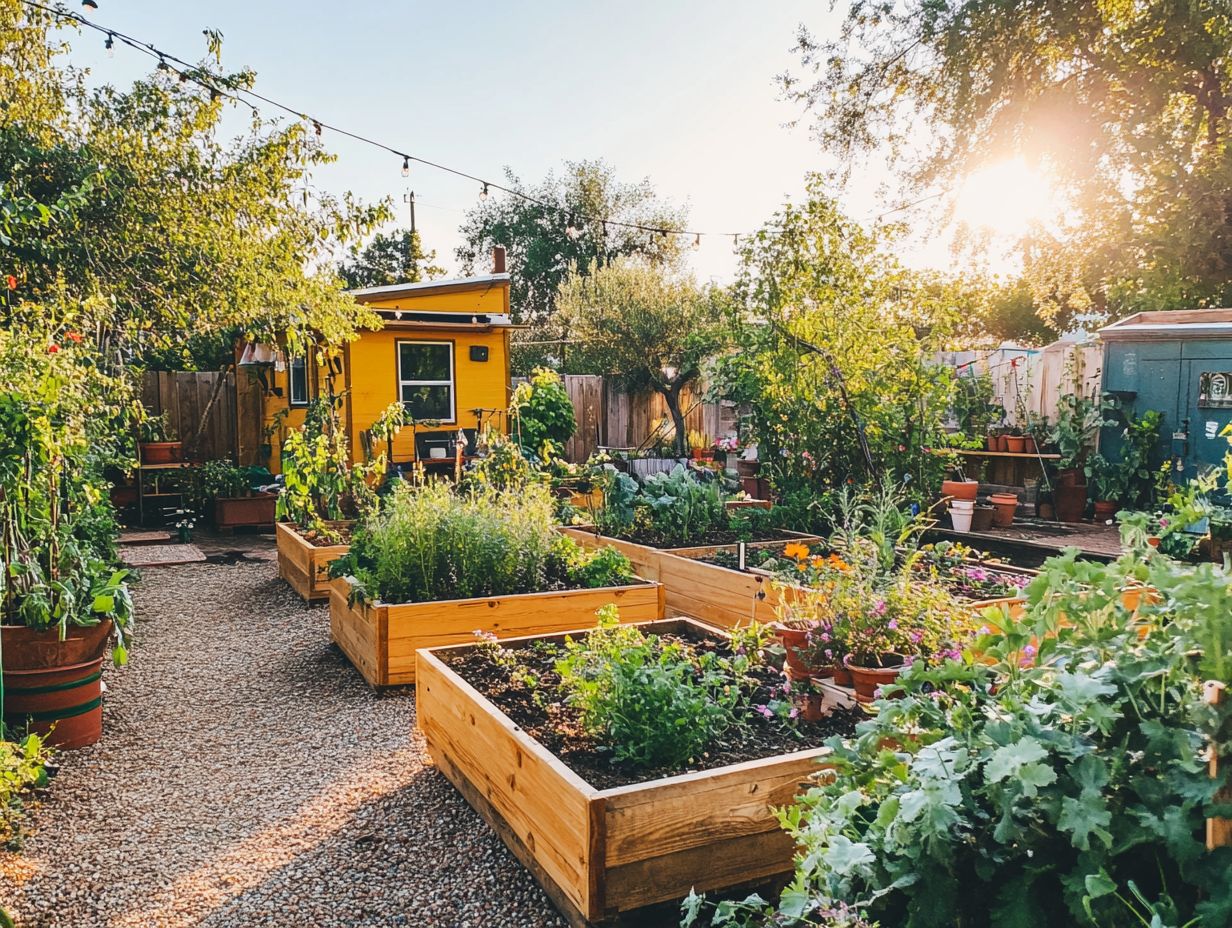
What is a tiny house garden, and how does it fit into urban gardening?
A tiny house garden is a small, compact garden space designed specifically for homes with limited outdoor space, such as tiny houses, apartments, or small yards. It often utilizes creative design techniques to make the most of the available space, providing a beautiful and functional outdoor area.
What are some design tips for creating a tiny house garden that maximizes outdoor space?
- Choose plants and decorations that are small in size.
- Use vertical gardening techniques to maximize space.
- Incorporate multi-functional elements, like a seating area that can also be used for storage.
- Use a color scheme to visually enlarge the space.
What are the benefits of having a tiny house garden for outdoor living?
- Provides a beautiful and relaxing outdoor space.
- Improves air quality and reduces noise pollution.
- Allows you to grow your own fresh produce.
- Increases the value of your home.
How do I choose the right plant varieties for my tiny house garden?
When choosing plants for a tiny house garden, consider their size, growth habits, and care requirements. Look for compact, low-maintenance plants suited for the amount of sunlight your garden receives. Incorporating edible plants and herbs can create a functional and beautiful garden.
Can I incorporate a water feature like a birdbath in my tiny house garden?
Yes! There are many ways to incorporate a water feature in a tiny house garden. Consider using a small fountain, birdbath, or even a small pond or water garden. Just ensure the size and placement won t take up too much space and fits with your garden’s overall design.
Are there any specific design considerations for a tiny house garden, particularly for mobile tiny houses?
Yes, when designing a tiny house garden, it’s important to keep in mind the limited space. Choose elements that complement the size and style of your home. Use creative solutions for storage, maximize vertical space, and consider using mirrors to create the illusion of a larger space.
In conclusion, by incorporating these tips and practices, you can create a thriving tiny house garden that maximizes your outdoor space and supports an eco-conscious lifestyle. Engage with your gardening community and start your journey today!

